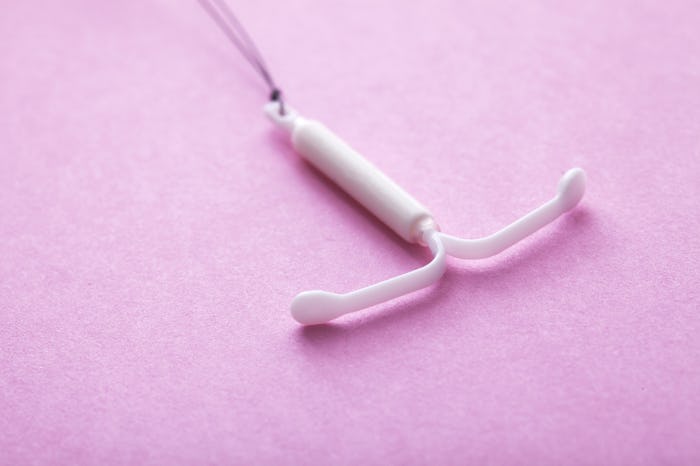When it comes to the Trump administration, nothing regarding your health care is certain. As President Donald Trump works on convincing Congress to repeal and replace the Affordable Care Act, he's also making moves to make health care more expensive for women. Earlier this month, he rolled back an ACA mandate that required employers to cover a woman's contraception by allowing companies to opt out, based on religious or moral objections to birth control. So if women end up having to pay out of pocket for their birth control, how much will an IUD cost you without insurance?
Without insurance, IUDs are pretty expensive. But don't let these numbers freak you out just yet — if your birth control is currently covered by your insurance, it still is, so it's not like prices will jump right away just because Trump signed an executive order last week. But even so, it's scary to think about how much the cost of an IUD could skyrocket if your insurance stops covering it.
The IUD is the most expensive form of birth control up front. You can use it over the course of a few years, so it's more like an investment. But if you don't have the cash up front, the cost is totally prohibitive for lower-income women who can't use the birth control pill.
Health care analytics company Amino studied "billions" of health insurance claims from 2014 to 2017, as TIME reported on Wednesday. The researchers looked at the Mirena and Skyla IUD brands, which use a hormone called progestin and the ParaGuard IUD, which is a non-hormonal copper device. They took the average of all three of the prices, including the cost from the health clinic for the insertion procedure and came up with an average cost for an IUD, state by state.
Without insurance, IUDs cost on average $1,000 nationwide, with the lowest cost being $800, as TIME summarized. That is totally out of control, especially when you realize that it's one of the most effective forms of birth control. According to the Centers for Disease Control, condoms fail 18 percent of the time and the birth control has a failure rate of 9 percent. IUDs, which require basically no maintenance and can work for years, have a failure rate of .08 percent, according to the CDC.
When the ACA became law and the IUD became more affordable, if not free for some women, women jumped at the chance to take advantage of this safe, effective, no-stress birth control method. A study called the Contraceptive CHOICE Project enrolled 10,000 women and found that 75 percent of them chose long-term, reversible methods like the IUD when they knew they could afford it.
In addition to allowing employers to opt out of covering a woman's birth control, both of the Republican drafted health care bills that came up in Congress this year chiseled away at Medicaid, Planned Parenthood, and access to safe abortions, meaning that women have pretty much no control over what happens to their bodies unless they're in a higher income bracket.
It's strange, because conservatives profess to be about protecting women and children, but access to birth control actually leads to less abortions, according to the Guttmacher Institute. And allowing women to choose when they get pregnant and carry a child to term is instrumental to not just their health and reproductive freedoms, but their career choices.
Alina Salganicoff, director of women's health policy at the Kaiser Family Foundation told CBS News last year, "As a society, we want to reduce unintended pregnancies and abortion rates. [The Choice Project] study has demonstrated that having access to no-cost contraception helps us get to that goal." Sounds simple enough, right? Because, as expert opinions and data prove, empowering women to make choices about their health is good for everyone.
Watch Romper's new video series, Romper's Doula Diaries:
Check out the entire Romper's Doula Diaries series and other videos on Facebook and the Bustle app across Apple TV, Roku, and Amazon Fire TV
